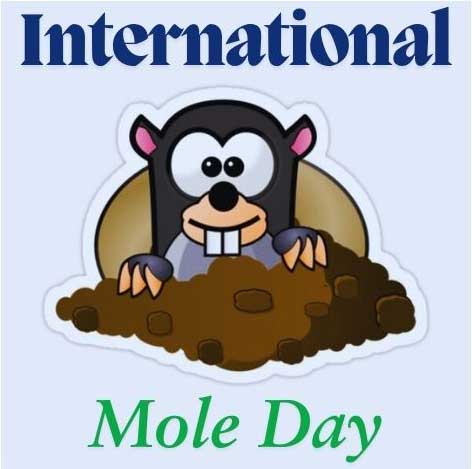
Introduction
Did you know there's a day dedicated to one of chemistry's most fundamental concepts? That's right, October 23rd is celebrated as International Mole Day! This quirky yet essential event highlights the importance of Avogadro's number and the mole concept in chemistry. Mole Day is an opportunity for educators, students, and chemistry enthusiasts alike to delve into this fascinating principle, a cornerstone in studying matter. Whether you're a seasoned chemist or just learning the basics, #InternationalMoleDay offers a unique way to deepen your understanding of chemical calculations and molecular science.

Let's dive into everything you need to know about International Mole Day: its origins, significance, and how it's celebrated around the globe.
What is International Mole Day?
International Mole Day is celebrated annually on October 23rd, from 6:02 AM to 6:02 PM, in honor of # Avogadro's Number (6.022 x 10²³), a basic measuring unit in chemistry. It is the day when chemistry enthusiasts, particularly in schools and universities, focus on the significance of the mole—an essential concept in chemical calculations that connects the atomic and macroscopic worlds.
But this day is not just about formulas and equations. It's also about making chemistry accessible, fun, and exciting, especially for students who may feel intimidated by the subject.
The Origins of International Mole Day
International Mole Day traces back to 1991 when chemistry teacher Maurice Oehler founded the National Mole Day Foundation (NMDF). He aimed to bring more enthusiasm and awareness to chemistry by introducing this unique holiday. The chosen time frame of 6:02 AM to 6:02 PM mirrors the mole concept, specifically Avogadro's constant (6.022 x 10²³), symbolizing the link between particles and moles.
Why Is the Mole Concept Important in Chemistry?
The mole concept is central to chemistry because it bridges the microscopic world of atoms and molecules with the macroscopic world we can see and measure. The mole allows chemists to count tiny particles, such as atoms and molecules, by weighing them in larger, more manageable quantities.
For example, you may measure flour in cups when baking, but chemists measure substances using the mole. One mole of any substance contains exactly 6.022 x 10²³ particles (whether atoms, molecules, or ions). This allows chemists to work with the atomic scale without directly dealing with astronomically large or small numbers.
How is International Mole Day Celebrated?
Mole Day is often celebrated in schools and colleges with educational activities, games, and experiments centered on the mole concept. Teachers might organize mole-themed events like "mole hunts" or mole-related trivia quizzes. Students might make "mole-staches" or wear mole-themed apparel to participate in the fun.
Some institutions even have themed mole day parties where students bake "mole" cupcakes or create mole-themed artwork. The idea is to make chemistry more engaging, turning a sometimes complex subject into something fun and approachable.
Famous Mole Day Themes
Every year, Mole Day has its theme, adding a layer of creativity to the celebrations. Past themes have included "Moles of the Caribbean," "Molebusters," and "Molar Eclipse." These fun names play on pop culture references while keeping the subject matter relevant to chemistry.
Schools and institutions participating in Mole Day can customize their events based on these themes, encouraging students to bring their ideas and interpretations into the festivities.
Avogadro's Number: The Science Behind Mole Day
To fully appreciate International Mole Day, it's essential to understand Avogadro's number. Named after Italian scientist Amedeo Avogadro, this constant (6.022 x 10²³) represents the number of particles in one mole of a substance. Avogadro's number is pivotal because it allows scientists to translate atomic mass units into grams, providing a way to calculate how much of a substance is needed for a reaction.
Understanding the History of Avogadro's Number
Although Amedeo Avogadro proposed his hypothesis in 1811, which stated that equal volumes of gases contain the same number of molecules under identical conditions of temperature and pressure, the concept of Avogadro's number wasn't officially coined until later. It was through the work of many other scientists, like Jean Perrin in the early 20th century, that Avogadro's number was measured and confirmed as a critical unit in chemistry.
Applying Avogadro's Number in Real-Life Chemistry
In chemistry, Avogadro's number is much more than a theoretical construct. It has practical applications in calculating chemical reactions, determining molar masses, and understanding the composition of substances. Avogadro's number provides the foundational framework, whether you're balancing chemical equations or determining the amount of product produced in a reaction.
For example, if you want to know how many carbon atoms are in 12 grams of carbon, you'd use Avogadro's number to calculate the number.
How Mole Day Helps Promote Chemistry Education
One of the primary purposes of International Mole Day is to enhance chemistry education by making the mole concept more relatable and easier to understand. By integrating hands-on activities, humorous themes, and engaging lessons, teachers can break down the complexity of the mole concept and encourage students to embrace chemistry.
This celebration raises awareness about the mole and sparks interest in the subject, providing a lighthearted break from the typical science curriculum.
Inspiring Future Scientists
International Mole Day is particularly effective at encouraging young students to pursue careers in STEM (Science, Technology, Engineering, and Mathematics). Many students report that Mole Day events and activities sparked their interest in chemistry, giving them a fun and accessible entry point into the subject.
Schools worldwide use Mole Day to foster a sense of curiosity in their students, showing them that chemistry isn't just about memorizing formulas—it's about understanding the world at a molecular level.
International Mole Day Around the Globe
While Mole Day may have started in the United States, it has since gained popularity worldwide. Today, schools and educational institutions in countries like Canada, the UK, Australia, and India celebrate Mole Day equally enthusiastically. The global nature of this event underscores the universal appeal of chemistry and the importance of scientific literacy.
Expanding the Celebration Beyond the Classroom
Although Mole Day primarily occurs in educational settings, its message resonates with the broader scientific community. Researchers and professional chemists use this day to highlight groundbreaking research, discoveries, and ongoing developments in molecular science.
This day also raises awareness of the global importance of science education, advocating for better access to chemistry resources and education for all.
Fun Mole Day Activities for Students and Teachers
If you're a teacher or a student looking to celebrate Mole Day, here are some fun ideas to incorporate into your classroom:
Mole-Themed Experiments
Teachers can design chemistry experiments based on the #MoleConcept, like determining the molar mass of ordinary household items or balancing chemical reactions. These experiments can help students grasp the real-world application of the mole concept.
Mole Day Art and Crafts
Why not combine chemistry with creativity? Many schools encourage students to make mole-themed art, like drawing "mole portraits" or designing Avogadro-themed posters. This adds a visual and imaginative element to chemistry that students of all ages can enjoy.
If you want to know about 'International Stuttering Awareness Day,' read this article, 'International Stuttering Awareness Day: Raising Awareness and Promoting Understanding.'
Conclusion
International Mole Day is a celebration that brings together chemistry lovers from all walks of life. It shines a spotlight on the mole concept, making it more approachable and fun for students while promoting a deeper understanding of molecular science. As schools and educators continue to find creative ways to celebrate this day, the importance of chemistry in our everyday lives becomes even more apparent. So, whether you're a student or a seasoned chemist, October 23rd is the perfect time to celebrate International Mole Day and all it represents.
FAQs
1. What is the significance of 6.022 x 10²³ in Mole Day?
This number, known as Avogadro's number, represents the number of particles in one mole of a substance, a central concept in chemistry.
2. How do schools typically celebrate Mole Day?
Schools celebrate with various activities such as mole-themed experiments, art projects, and educational events to engage students in learning about chemistry.
3. Who started International Mole Day?
Maurice Oehler, a chemistry teacher, founded the National Mole Day Foundation in 1991 to promote interest in chemistry.
4. Why is October 23rd chosen as Mole Day?
October 23rd (10/23) aligns with Avogadro's number (6.022 x 10²³), making it the perfect day to celebrate the mole concept in chemistry.
5. How does Mole Day benefit students?
Mole Day makes chemistry fun and accessible, helping students better understand complex concepts and inspiring some to pursue careers in science.





